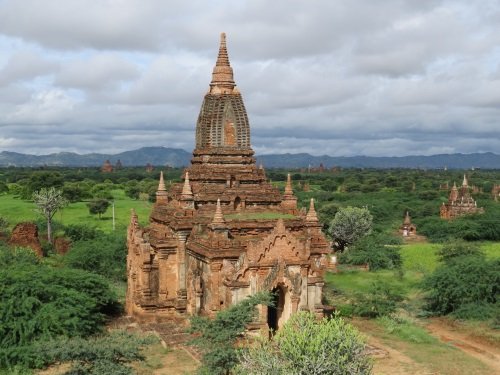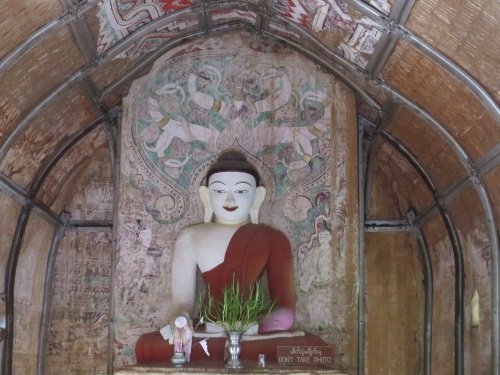Bagan
was a powerful kingdom from the 11th to the late 13th century: the empire stretched over almost all of what now is Myanmar. The remains of its ancient capital city comprise over 2,000 temples, monasteries and pagodas. They were constructed in a religious construction frenzy by Bagan’s rulers and wealthy subjects. Bagan at this time also became a center for religious study, attracting devotees from afar. Although it lost its prominence in the 14th century, the site was never abandoned and has stayed a pilgrimage destination throughout.

|
|
View from Dhamma-ya-za-ka Zedi
|
Nowadays Bagan is Myanmar’s tourist central, and it delivers proof that even the gentle Burmese can turn into annoying souvenir sellers & touts given a steady influx of wealthy tourists. I stayed in Bagan for 4 nights, using it also as a base for a side-trip to the
wooden monasteries of Pakhangyi and Pakhannge
. It was the end of the rainy season, and I experienced mostly partly cloudy weather during the day and a daily heavy downpour around 3.30 p.m.. I ‘did’ two longer trips of exploration among the monuments, once by mountainbike and the other time cruising around on an e-scooter (a rightly popular mode of transportation at the site).
There’s no clear ‘Angkor Wat’ among Bagan’s religious monuments, no flagship temple or monastery that serves as the site’s iconic image. I would say that the two best contenders are the Ananda and Sulamani Temples. The Ananda was built in a fusion of Mon and Indian styles, and today is the most lively among the temples with worshipping Burmese. There’s an interesting tier of green terracotta glazed tiles around its outer wall. The Sulamani (aptly meaning 'Crowning Jewel') looks more refined, also more ‘complete’ than many of the other temples. It is tempting to make comparisons to
Angkor
as the two sites are so similar in many aspects, but either because of the worse state of conservation or the hasty (re)construction work I found Bagan less impressive in its artistic features.

|
|
Interior with paintings, Upali Thein
|
It is worth visiting Bagan's Archaeological Museum early during your stay. The museum is housed in a grand building with lots of empty space, but many of the exhibits are of good quality. Signs in English tell that they do apologize for the electricity problems, and are working on a better museum! Here you can see a model of how Bagan looked like during its heyday: now only the temples and pagodas remain, but in between there was a city of 50,000 – 200,000 inhabitants living in wooden houses. They also display the 55 hair styles for women (and 5 for men) that can be seen at the various wall paintings in Bagan, all variations on long black hair in a ponytail.
A lot of the joy of Bagan comes from exploring its smaller or more outlying temples and pagodas. The good ones include the Ananda Ok Kyaung (a chapel with detailed murals, including depictions of Portuguese traders), the Upali Thein (well-preserved murals, can only be seen peeking through the closed door), the Tayok-pyi pagoda (has a façade with fine carvings) and the big red Dhamma-ya-za-ka Zedi in the morning light.

|
|
Lots of detail at the Tayok-pyi pagoda
|
2017 is now the estimated admission year of this major historical site to the WH list. It fell victim before to possibly the worst case of polarization in the history of World Heritage, a whole thesis can be written about the stand-off between the Myanmar military rulers and UNESCO & other representatives of the international community. It ended up with a Referral in 1997, stating the need for buffer zones and management plans but not mentioning the shoddy reconstruction techniques, the construction of the Nann Myint Viewing Tower in 2005 or the displacement of the population of Old Bagan that were among the critical issues earlier on.



